Small overlap front: driver-side
Rating applies to 2020-23 models built after September 2019
Tested vehicle: 2020 Jeep Renegade Latitude 4-door 4wd
The Jeep Renegade was introduced in the 2015 model year. Beginning with the 2019 model year, the front-end structure, front door hinge pillars, and front door sills were reinforced to improve occupant protection in small overlap and moderate overlap frontal crashes.
Beginning with 2020 models built after September 2019, an additional modification was made to the front-end structure to further improve occupant protection in driver-side small overlap crashes.
| Evaluation criteria | Rating |
|---|---|
| Structure and safety cage | |
| Driver injury measures | |
| Head/neck | |
| Chest | |
| Hip/thigh | |
| Lower leg/foot | |
| Driver restraints and dummy kinematics | |
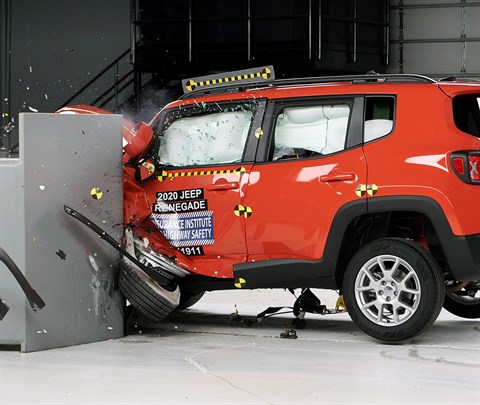
Action shot taken during the driver-side small overlap frontal crash test.
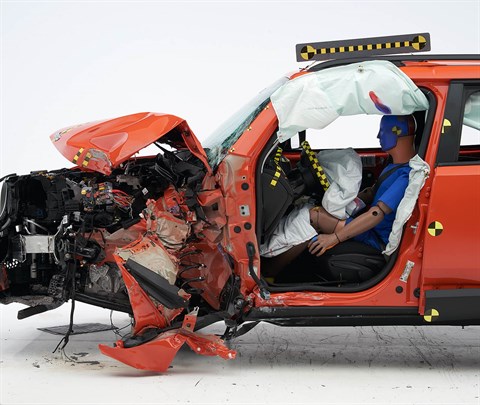
The dummy's position in relation to the door frame, steering wheel, and instrument panel after the crash test indicates that the driver's survival space was maintained very well.
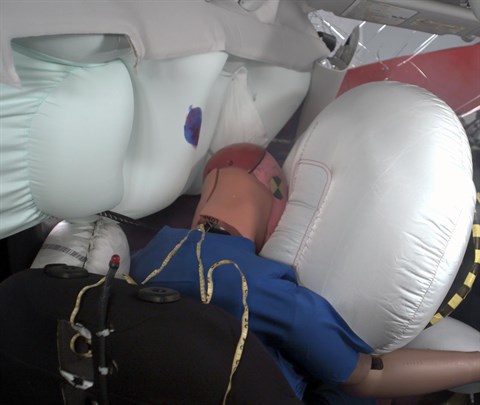
The frontal and side curtain airbags worked well together to keep the head from coming close to any stiff structure or outside objects that could cause injury.
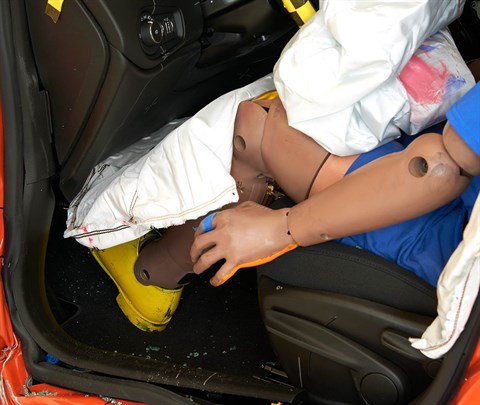
The driver's space was maintained well, and risk of injuries to the dummy's legs and feet was low.
Small overlap front: passenger-side
Rating applies to 2019-23 models
Tested vehicle: 2019 Jeep Renegade Latitude 4-door 4wd
The Jeep Renegade was introduced in the 2015 model year. Beginning with the 2019 model year, the front-end structure, front door hinge pillars, and front door sills were reinforced to improve occupant protection in small overlap and moderate overlap frontal crashes.
Passenger-side small overlap frontal ratings are assigned by the Institute based on a test conducted by Fiat Chrysler.
| Evaluation criteria | Rating |
|---|---|
| Overall evaluation | |
| Structure and safety cage | |
| Passenger injury measures | |
| Head/neck | |
| Chest | |
| Hip/thigh | |
| Lower leg/foot | |
|
Passenger restraints and dummy kinematics
The dummy’s head contacted the right side of the frontal airbag but began to slide to the right into the gap between the frontal and side curtain airbags, leaving the head vulnerable to contact with forward structure. The side curtain airbag deployed and has sufficient forward coverage to protect the head from contact with side structure and outside objects. The side torso airbag also deployed. | |
| Driver injury measures | |
| Head/neck | |
| Chest | |
| Hip/thigh | |
| Lower leg/foot | |
| Driver restraints and dummy kinematics | |
Moderate overlap front: original test
Rating applies to 2019-23 models
Tested vehicle: 2019 Jeep Renegade Latitude 4-door 4wd
The Jeep Renegade was introduced in the 2015 model year. Beginning with the 2019 model year, the front-end structure, front door hinge pillars, and front door sills were reinforced to improve occupant protection in small overlap and moderate overlap frontal crashes.
Moderate overlap frontal ratings are assigned by the Institute based on a test conducted by Fiat Chrysler.
| Evaluation criteria | Rating |
|---|---|
| Overall evaluation | |
| Structure and safety cage | |
| Driver injury measures | |
| Head/neck | |
| Chest | |
| Leg/foot, left | |
| Leg/foot, right | |
| Driver restraints and dummy kinematics | |
Moderate overlap front: updated test
Rating applies to 2021-23 models
Tested vehicle: 2021 Jeep Renegade Latitude 4-door 4wd
The Jeep Renegade was introduced in the 2015 model year. Beginning with the 2019 model year, the front-end structure, front door hinge pillars, and front door sills were reinforced to improve occupant protection in small overlap and moderate overlap frontal crashes.
| Evaluation criteria | Rating |
|---|---|
| Overall evaluation | |
| Structure and safety cage | |
| Driver injury measures | |
| Head/neck | |
| Chest | |
| Thigh/hip | |
| Leg/foot | |
| Driver restraints and dummy kinematics | |
| Rear passenger injury measures | |
| Head/neck | |
| Chest | |
| Thigh | |
|
Rear passenger restraints and dummy kinematics
| |
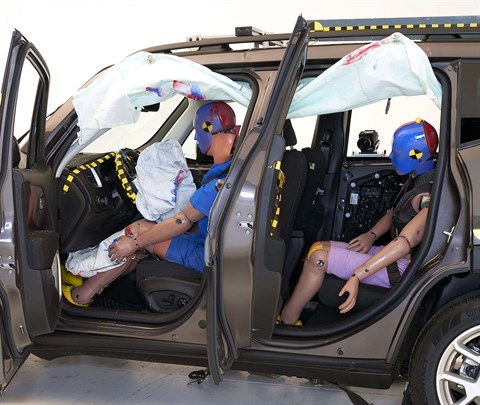
View of the vehicle after the crash showing the airbags and damage to the occupant compartment.
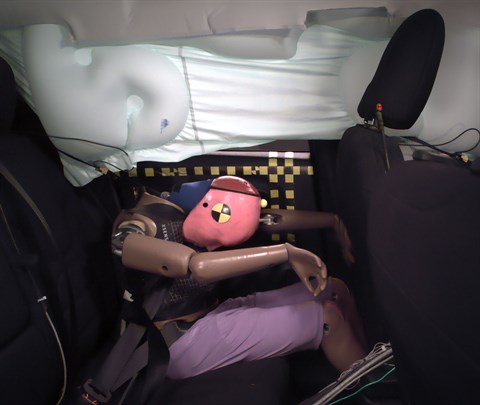
The rear passenger dummy's head remained a safe distance from the front seatback.
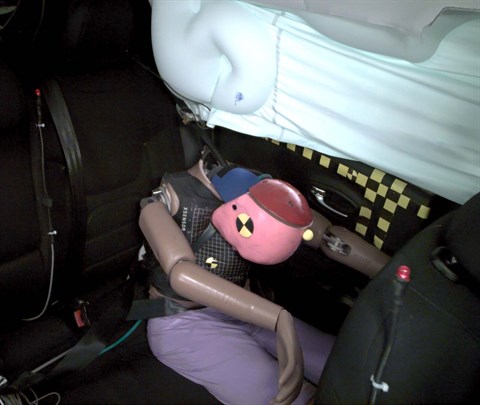
Rear passenger dummy injury values indicate a likely risk of injury to the head or neck and chest. During the crash, the shoulder belt remained in an ideal position on the dummy’s chest.
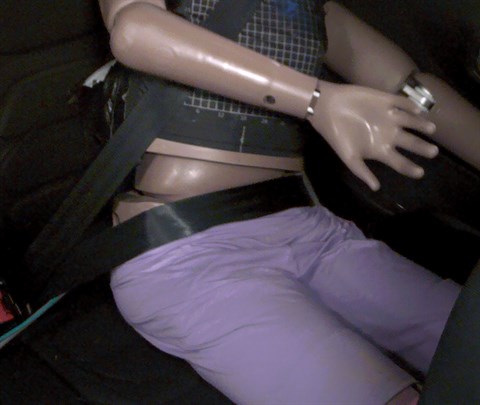
The rear passenger dummy's lap belt remained in the ideal position on the pelvis.
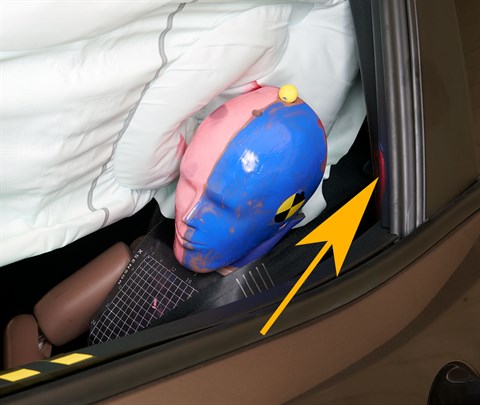
During rebound, the rear passenger dummy's head moved outside of the side curtain airbag and hit the C-pillar hard. The head protection is inadequate and puts the head at risk of possible contact with outside objects.
Side: original test
Rating applies to 2019-23 models
Tested vehicle: 2019 Jeep Renegade Latitude 4-door 4wd
The Jeep Renegade was introduced in the 2015 model year. Two side impact tests of the Renegade were conducted, the first by the Institute of a 2015 model and the second by Fiat Chrysler of a 2019 model. Side ratings are based on both tests.
| Evaluation criteria | Rating |
|---|---|
| Overall evaluation | |
| Structure and safety cage | |
| Driver injury measures | |
| Head/neck | |
| Torso | |
| Pelvis/leg | |
| Driver head protection | |
| Rear passenger injury measures | |
| Head/neck | |
| Torso | |
| Pelvis/leg | |
| Rear passenger head protection | |
Side: updated test
Rating applies to 2019-23 models
Tested vehicle: 2021 Jeep Renegade Latitude 4-door 4wd
The Jeep Renegade was introduced in the 2015 model year.
| Evaluation criteria | Rating |
|---|---|
| Overall evaluation | |
| Structure and safety cage | |
| Driver injury measures | |
| Head/neck | |
| Torso | |
| Pelvis | |
| Driver head protection | |
| Rear passenger injury measures | |
| Head/neck | |
| Torso | |
| Pelvis | |
| Rear passenger head protection | |
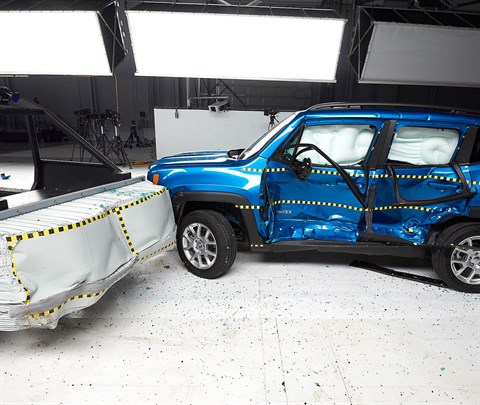
View of the vehicle just after the crash test.
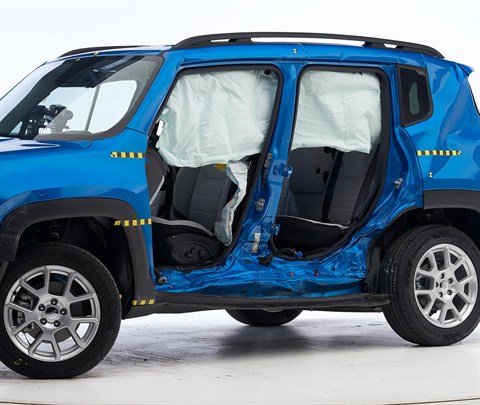
View of the vehicle after the crash with doors removed, showing the side airbags and damage to the occupant compartment.
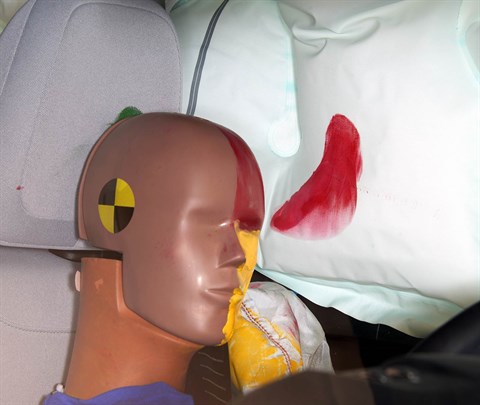
Smeared greasepaint shows where the driver dummy's head was protected from being hit by hard structures by the side airbags.
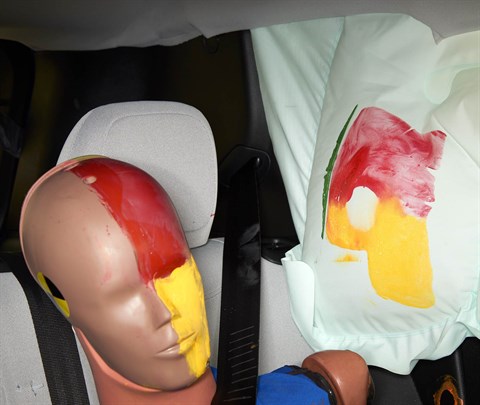
Smeared greasepaint shows where the rear passenger dummy’s head was protected by the side airbag.
Roof strength
Rating applies to 2019-23 models
Tested vehicle: 2019 Jeep Renegade Latitude 4-door 4wd
| Overall evaluation | |
|---|---|
| Curb weight | 3,365 lbs |
| Peak force | 18,051 lbs |
| Strength-to-weight ratio | 5.36 |
Head restraints & seats
Seat type: Power cloth seat
| Overall evaluation | |
|---|---|
| Dynamic rating | |
| Seat/head restraint geometry |
About the head restraint & seat test
Currently, IIHS tests apply only to front seats.
Headlights
Ratings are given for 3 different headlight variations available on this vehicle.
Trim level(s)
- Latitude trim equipped with Luxury Group I package
- 80th Anniversary trim equipped with Luxury Group II package
- Limited trim equipped with Luxury Group II package
| Evaluation criteria | Rating |
|---|---|
| Low-beam headlight type | LED projector |
| High-beam headlight type | LED reflector |
| Curve-adaptive? | No |
| High-beam assist? | Yes |
|
Overall rating | |
| Distance at which headlights provide at least 5 lux illumination: | |
Low beams
On the straightaway, visibility was good on the left side of the road and inadequate on the right side. On curves, visibility was good on both right curves, fair on the sharp left curve and inadequate on the gradual left curve.
The low beams never exceeded glare limits.
High beams
On the straightaway, visibility was good on the right side of the road and inadequate on the left side. On curves, visibility was good on both right curves and fair on both left curves.
High-beam assist compensates for some limitations of this vehicle's low beams on the straightaway, on both left curves and on the gradual right curve.
Trim level(s)
- Trailhawk trim equipped with Luxury Group III package
| Evaluation criteria | Rating |
|---|---|
| Low-beam headlight type | LED projector |
| High-beam headlight type | LED reflector |
| Curve-adaptive? | No |
| High-beam assist? | No |
|
Overall rating | |
| Distance at which headlights provide at least 5 lux illumination: | |
Low beams
On the straightaway, visibility was good on the left side of the road and inadequate on the right side. On curves, visibility was good on both right curves, fair on the sharp left curve and inadequate on the gradual left curve.
The low beams never exceeded glare limits.
High beams
On the straightaway, visibility was good on the right side of the road and inadequate on the left side. On curves, visibility was good on both right curves and fair on both left curves.
Trim level(s)
- Sport trim
- Jeepster trim
- Latitude trim
- Upland trim
- 80th Anniversary trim
- Islander trim
- Limited trim
- Trailhawk trim
| Evaluation criteria | Rating |
|---|---|
| Low-beam headlight type | Halogen reflector |
| High-beam headlight type | Halogen reflector |
| Curve-adaptive? | No |
| High-beam assist? | No |
|
Overall rating | |
| Distance at which headlights provide at least 5 lux illumination: | |
Low beams
On the straightaway, visibility was inadequate on both sides of the road. On curves, visibility was inadequate in all 4 tests.
The low beams never exceeded glare limits.
High beams
On the straightaway, visibility was inadequate on both sides of the road. On curves, visibility was fair on the gradual right curve and inadequate on the sharp right and both left curves.
Front crash prevention: vehicle-to-vehicle
Seat belt reminders
Rating applies to 2021-23 models
| Evaluation criteria | Rating |
|---|---|
| Overall evaluation | |
| Front row | |
| Unbelted occupant alert (audible & visual) | |
| Initiation time | |
| Duration | Long enough (90+ seconds) |
| Volume | |
| Audio frequency | |
| Second row | |
| Startup status alert (visual) | None |
Child seat anchors
Rating applies to 2019-23 models
| Evaluation criteria | Rating |
|---|---|
| Overall evaluation | |
| Vehicle trim | Latitude |
| Seat type | cloth |
This vehicle has 2 rear seating positions with complete child seat attachment (LATCH) hardware.
It has 1 additional seating position with a tether anchor only.
| Evaluation criteria | Rating |
|---|---|
| Overall evaluation | |
| Vehicle trim | Latitude |
| Seat type | cloth |
| Rating icon | Rating |
|---|---|
| G | Good |
| A | Acceptable |
| M | Marginal |
| P | Poor |
| Seating positions that rely on borrowed lower anchors or have only a tether anchor available are not rated. | |
thether anchor symbol | Tether anchor |
lower anchor symbol | Lower anchors |
| Lower anchor(s) can be borrowed from adjacent positions(s) | |
| No hardware available |
Details by seating position
| Position | Rating |
|---|---|
| 1 | |
| Tether anchor | |
| easy-to-find location | |
| no other hardware could be confused for anchor | |
| Lower anchors | |
| too deep in seat | |
| not too much force needed to attach | |
| easy to maneuver around anchors | |
| 2 | |
| Tether anchor | |
| easy-to-find location | |
| no other hardware could be confused for anchor | |
| Lower anchors | |
| none available | |
| 3 | |
| Tether anchor | |
| easy-to-find location | |
| no other hardware could be confused for anchor | |
| Lower anchors | |
| too deep in seat | |
| not too much force needed to attach | |
| easy to maneuver around anchors |
